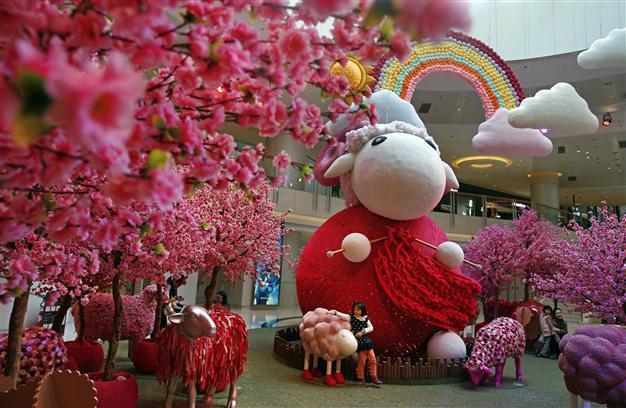Sheep, goat or ram?
Aylin Öney Tan - aylinoneytan@yahoo.com

AP Photo
Which one do you prefer: sheep, goat or ram? This is not a selective main choice in a menu, but a rather critical question on the significance of this year. There seems to be a confusion on which animal really signifies the forthcoming New Year in the Chinese calendar. Every Asian country seems to be picking its favorite: Koreans favor ram, Chinese, Japanese and Taiwanese pick sheep, while Vietnamese prefer goat. In reality all are correct, only the truth is lost in translation.
Actually the Chinese word “yáng” tags the year, which can be translated to all of these three animals, often depicted with arch-like horns. The ram is predominately the symbol of choice, perhaps because it is the uncastrated adult sheep, more likely to bear a symbolism of power. Sometimes it is also translated as the goat, maybe picked for its playful and fugitive character and is charged with symbols of freedom. Sheep is the mainstream choice, with its easygoing cuddly, peaceful and domestic connotations. Sheep are also milder in nature, thus preferred for a less tormented year. But then even gazelle fits onto the scene if one relies on the translation of the word only. The true answer to “yang” might be simply just any ruminating even-toed ungulate with horns. It is your choice to pick this year’s symbol for the Chinese year and for your table as well.
However on the Chinese table, pork is the stable and supreme meat. This is mostly because China had been home to the domestication of the pig. The pig is a very versatile animal, eaten from nose to tail. Its reproduction is fast, it multiplies to huge numbers in a remarkably short time, not picky in its fodder choices and thus very cost efficient. It is tasty, has a less fibrous meat compared to other meats, so it is much easier to cook it an enjoyable fashion. Given the number of people in China, pork seems to be the right meat, along with chicken, that can feed masses. Together with its geographical origins, pork is practically the only choice of sustenance in a carnivorous diet in China.
For understandable reasons, mutton or lamb is seldom eaten in Chinese cuisine. It is only in the North or North West regions, often populated by pig-detesting Muslim communities or in regions where pig farming is not suitable in the vast steppes.
The region that savors lamb or mutton most is Xinjiang, the Uyghur region. There, skewered lamb kebab is a usual street food, similar to the Turkish streetscape. This culinary closeness is understandable not only by cultural connections, but also by geographical conditions. As the grassy steppes of Western Central Asia are most suitable for herding sheep, Anatolia has been the homeland for these animals. The domestication of goats and sheep started first in upper Mesopotamia, the vicinities of Göbeklitepe near Urfa, and from there it spread to other geographies east and west. When we see depictions of the early Eastern Anatolian Norduz variety sheep and goats with their long-arching horns, they are suspiciously similar, almost identical to symbolic drawings of the yáng figure. Who knows, maybe it was a Turkish-bound contribution to the Chinese calendar? We always forget the initial Turkish calendar was also on based animal signs, just like its Chinese counterpart.
Let’s not fuss about the animal choice, but simply call 2015 “The Year of the Yáng.” Feb. 18 is the New Year’s Eve and the Yáng Year starts on the 19th. May be the whole world needs to go into a milder yáng nature, so let’s celebrate with an auspicious dish, longevity noodles, gentle and soothing just like the yang character; and crucially vegetarian as my wish is for no more killing in 2015.
Bite of the week
Recipe of the Week: Choose the longest noodles you can find. Boil 100 g
of noodles per head in lots of salted water. Meanwhile, chop finely a
handful of spring onions and baby spinach for each person. When the
noodles are done, drain and transfer into a bowl. Scatter with chopped
greens. Heat 2-3 tablespoons oil per head, when sizzling hot, remove
from heat add 1 teaspoon each of minced garlic and fresh ginger and pour
over the noodles. Add about 2 tablespoons light soy sauce per head and
toss thoroughly. For a long life, try to eat as if like swallowing;
never, ever cut the noodles; it may bring bad luck and this might be the
last bowl of noodles you enjoyed.
Fork of the Week:
Shangri-La Bosphorus Hotel in Beşiktaş, Istanbul has already started to
celebrate the Yáng Year. Shang Palace, one of the leading Chinese
restaurants in town, offers a New Year’s menu not only focused on food,
but for good causes, too. If you wish to hang your New Year wishes on
the wish-tree, just donate 5 Turkish Liras per wish to the Tohum Autism
Foundation and offer a helping hand to autistic children and their
families. So nicely fit with the nature of the genteel coming year.
Check the website for the autism foundation for their upcoming
activities and projects. http://en.tohumotizm.org.tr/
Cork of the
Week: You may want to abstain from alcohol and go for tea this week. At
Shangri-La splurge to experience the unique Kung Fu tea master’s show,
which acrobatically displays the fine art of the Chinese tea ceremony
with an elongated pot. On a budget, buy a single ball of jasmine green
tea that opens up into a beautiful lotus-like flower when you pour hot
water over it. Tea is for tranquility indeed.
